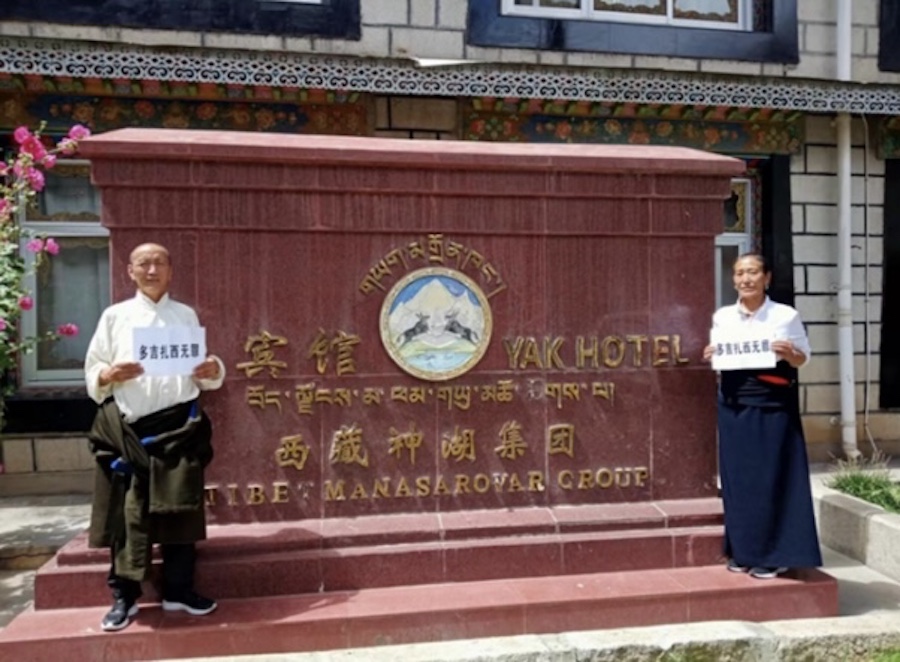By Tsewang Namgyal
“The Tibetan settlements are preserving a very rare treasure for the human species. This is the ability to change the human mind and the brain it turns out. Recent research has shown the techniques preserved in the settlements makes people more compassionate, more present and more mindful. This is so important but it is a fragile treasure.”
Daniel Goleman, psychologist and award-winning author of Emotional Intelligence in support of Reimagining Doeguling effort.
The Tibetan settlements in India have the potential to have a transformative positive impact on the world. It is in these settlements that India’s ancient Nalanda tradition is preserved in its most extensive form. Much of the credit in maintaining this knowledge system is attributable to His Holiness the Dalai Lama, the elder generation of Tibetans, the monasteries, Central Tibetan Administration (CTA), the Indian government and public, and supporters around the world.
The settlements are now in a fragile position due to global economic, political, technological and cultural trends despite the demonstrated benefits of the knowledge preserved in these settlements. Many (if not majority) of the young minds in the settlements have one goal – move to the West or urban India due to lack of economic opportunities in the settlements. As a former resident of one of the settlements, I understand the desire to move out.
From a pure economic stand point, it would make sense to encourage emigration from the settlements. However, without the community and a sustainable economic model, the monasteries in the settlements will not survive independently. In addition, the lay community is very important not only as a source of support to the monasteries but they preserve Tibetan art, customs and language. It is critical to develop the conditions to not only retain the community but attract new talent and funds to further increase the vibrancy of the settlements.
Developing an economic model that would only enrich the settlement residents would not be sufficient. Tensions with the surrounding Indian population will increase if an integrated development plan is not considered. In other words, success of the settlements without regard of the surrounding region will lead to other issues. It is important that development is planned in a way that it fulfills the vision of the surrounding region. It is critical for the surrounding community to also benefit from any development of the settlements.
Modern technology brings its benefits but also challenges that are breaking traditional discipline, especially in the monasteries. I heard from a volunteer friend that elder monks do not know how to deal with the benefits and challenges that the internet brings.
The current governance structure and lack of transparency of the monasteries does not encourage long-term planning and operational efficiency. The physical infrastructures of the settlements are poor and the lack of water resource pose an existential threat to certain settlements.
CTA officials recognize the importance of revitalizing the settlements and have taken steps to address the challenges. There are a growing number of Tibetan officials that recognize the top-down approach is not working to address the current challenges. It is encouraging to see CTA officials allowing a bottom-up development effort.
Few of the leaders in the largest Tibetan settlement in south India – Doeguling, Mundgod approached me in December of 2012 to see if I could be of assistance. After accepting their offer, I quickly enlisted a group of family and friends with expertise and appreciation of the value of the knowledge system to serve as advisors and volunteers.
A big source of inspiration was the early support I received from senior Karnataka State government officials and CTA officials. Karnataka state government officials mentioned to me that the Reimagining Doeguling effort fits into their vision and offered to provide us their support. The slogan of Karnataka state’s tourism board is “One state, many worlds.”
During discussion with community leaders I mentioned that it would be important for us to develop a vision for Doeguling that will inspire all stakeholders (both Doeguling and non-Doeguling residents). Since then we have continued to refine the vision. Currently our vision is to make Doeguling the primary place to study the Nalanda traditions and the Tibetan culture for many generations.
We named our effort Reimagining Doeguling Tibetan Settlement (RDTS) to rebrand Doeguling from a poor dying Tibetan refugee settlement to a vibrant educational center based on compassion and reasoning. Our vision is inspired by the ancient Nalanda University. We have made it clear that the vision may be further refined but will be always driven by depth and not entertainment.
Doeguling is in a unique position to achieve its vision for the following reasons: (i) Doeguling is home to two of the three largest Tibetan monasteries – Ganden and Drepung – besides it hosts the different Tibetan Buddhist schools; (ii) the settlement is easily accessible by air, rail and road; (iii) it is spread over 4000 acres of land allowing flexibility for expansion; (iv) this effort is led by a very committed local team representing approximately the 16,000 plus community members; and (v) the effort is endorsed by His Holiness the Dalai Lama, CTA and the Karnataka Tourism ministry.
As a result of our effort with the community and support of various stakeholders, we were able to help the community get the Karnataka State government to supporting funding repair of the main road at the cost of around $500,000; complete a detailed assessment report worth $100,000; raise over $30,000 of working capital; organize the community leaders in an Executive Committee and Managing Committee structure that would be both representative and efficient; train community leaders; recruited a global team of resourceful and experienced Advisors and volunteers; provide feedback to CTA to help negotiate a sensible land lease agreement with the Indian government and raise awareness through social media of Doeguling’s value to the world.
Currently in Doeguling there are no zoning and building codes. Constructions of buildings occur without much consideration to the infrastructure situation, resource limitation, health and how the buildings will fit into the overall plan. This lack of planning and regulations will make it difficult in the future to impose rules to sustainably develop Doeguling.
If a detailed business plan, master plan, zoning and building codes are not developed there is a danger that unplanned development will occur similar to what has been witnessed in Dharamsala. Zoning will help organize the land in a way that will maximize land usage and help achieve our vision.
We anticipate that the scope of work of the business plan will initially review the existing conditions such as geotechnical, layout, legal and regulatory review, environmental and safety implications, and infrastructure system (principally water, electricity and sewage). This will be followed by a Market Assessment (which will include a comparison of regional international projects), an Economic analysis, a Feasibility study (of individual business opportunities) and a Master plan.
The study will be broken into phases where the community will be able to provide feedback in a town hall style format.
Consistent with the overall vision for the development, RDTS has identified the following development potentials which we intend to fully explore in our overall business plan: Nalanda Center educational facilities which include a museum and library; a Tibetan Medical Center; Retirement homes and international standard hotels and restaurants.
The study will focus on business enterprises in and around Doeguling that will provide a healthy revenue stream of regular dividend distribution with low volatility. Priority will be given to enterprises that will enhance the Nalanda tradition and Tibetan culture.
The plan will be based on pragmatism and will focus on attracting experienced, qualified and ethical businesses with funding capability and expertise to co-develop business enterprises. This can only be done if we are able to provide appropriate conditions and reasonable financial returns. In addition, we will explore how Doeguling will be connected to the other local attractions in Karnataka state to encourage a mutually beneficial relationship.
On August 10, 2016 after consulting with RDTS Advisory Board, I concluded that the community would need to meet three conditions prior to our offer to assist in working on a detailed business plan and master plan. The conditions were provided to make sure the community has both the ability and willingness to implement a business plan and a master plan that would be very time consuming and intensive.
The three conditions provided to RDTS leaders before considering a detailed business plan and master plan are:
1. Finalize the land lease agreement between CTA and Government of India.
This is critical because without clarity on the land status it would be difficult to work on a business plan. RDTS has provided CTA with terms on the initial draft of the lease agreement that will increase the land value and potential of the leased land. Such as lease will also benefit Karnataka state as it will attract good investment and improve livelihood.
2. RDTS must raise internally within the community and existing supporters equivalent of US$30 K towards financing a detailed business and master plan. The cost of such a study will be significantly higher depending on the experience and reputation on the consultant.
This will be used as seed funds to raise additional money to fund the study and plan. Besides a source of funds, the purpose of the money raised within the community is to develop confidence in the community’s interest in implementing the plan.
3. Demonstrate improved coordination with CTA.
This effort is unique since the leadership comes from within the community and not top down. It is critical that there is clarity and support from the CTA on this initiative before Advisors and supporters put too much effort.
In mid-December a number of supporters of RDTS including the former head of the World Bank to south Asia – Mr. Joe Wood – are scheduled to visit Doeguling. Our purpose will be to understand the current needs, capacity and interest of the community. We will follow up on few key initiatives such as working to organize a future international Nalanda related festival in Doeguling and build community capacity.
Our purpose in hosting such a festival in Doeguling hopefully end of 2017 or 2018 is to unify our efforts and to jumpstart the work of RDTS reaching out into the wider community of supporters and participants. We envision the key theme of the festival will be to highlight Nalanda tradition but it will also bring awareness about Karnataka state and Tibetan culture. The festival will also help Karnataka state achieve one of its strategic objectives to make Karnataka one of the most preferred tourist destination in the India and the world at large.
During the visit we will also review the status of the above three condition and see if adjustments need to be made considering the ground situation. Meanwhile, one of our architect volunteers (Duke Beeson) has initiated a rendering of the settlement in consultation with the RDTS leaders to help the community to visualize and inspire towards a future realized Doeguling.
For many of us volunteering on this effort, we are driven by gratitude and appreciation to the efforts of the contemporary Nalanda masters of today like His Holiness the Dalai Lama and masters of the past like Nagarjuna. After three plus years of volunteering by many of us, we fully appreciate the many challenges ahead for both the community and supporters.
Unlike the past political and economic challenges where the major monasteries and community were able to survive, this time it will be near impossible to replicate in particular the great monasteries. Although aspects of the tradition may be preserved in the Tibetan community centers in the West and urban India, it will be near impossible to preserve the depth of the Nalanda tradition and Tibetan culture.
If we succeed in developing a viable economic model for Doeguling, I believe other settlements can adopt a similar strategy of a bottom-up development strategy with a common positive vision. History has demonstrated that economic opportunities will attract talent. Viable Tibetan settlements will help reduce the financial pressure on CTA and achieve its objective to preserve this beneficial culture. Equally important, viable settlements will be a great gift that will keep on giving Karnataka state, India and the world by serving as an anchor of compassion and wisdom.
The author is an MBA graduate (Beta Gamma Sigma Honor Society member) from the Thunderbird School of Global Management and works in the Investment Banking field in New York City. He currently serves on the Board of The Tibet Fund









